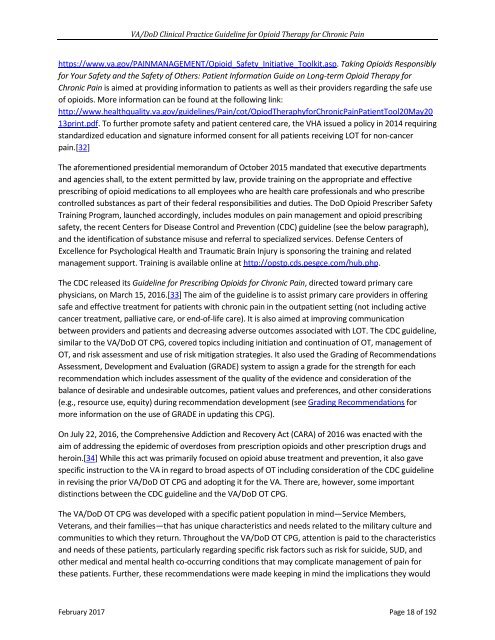VA/DoD CLINICAL PRACTICE GUIDELINE FOR OPIOID THERAPY FOR CHRONIC PAIN
2lfFhbO
2lfFhbO
You also want an ePaper? Increase the reach of your titles
YUMPU automatically turns print PDFs into web optimized ePapers that Google loves.
<strong>VA</strong>/<strong>DoD</strong> Clinical Practice Guideline for Opioid Therapy for Chronic Pain<br />
https://www.va.gov/<strong>PAIN</strong>MANAGEMENT/Opioid_Safety_Initiative_Toolkit.asp. Taking Opioids Responsibly<br />
for Your Safety and the Safety of Others: Patient Information Guide on Long-term Opioid Therapy for<br />
Chronic Pain is aimed at providing information to patients as well as their providers regarding the safe use<br />
of opioids. More information can be found at the following link:<br />
http://www.healthquality.va.gov/guidelines/Pain/cot/OpiodTheraphyforChronicPainPatientTool20May20<br />
13print.pdf. To further promote safety and patient centered care, the VHA issued a policy in 2014 requiring<br />
standardized education and signature informed consent for all patients receiving LOT for non-cancer<br />
pain.[32]<br />
The aforementioned presidential memorandum of October 2015 mandated that executive departments<br />
and agencies shall, to the extent permitted by law, provide training on the appropriate and effective<br />
prescribing of opioid medications to all employees who are health care professionals and who prescribe<br />
controlled substances as part of their federal responsibilities and duties. The <strong>DoD</strong> Opioid Prescriber Safety<br />
Training Program, launched accordingly, includes modules on pain management and opioid prescribing<br />
safety, the recent Centers for Disease Control and Prevention (CDC) guideline (see the below paragraph),<br />
and the identification of substance misuse and referral to specialized services. Defense Centers of<br />
Excellence for Psychological Health and Traumatic Brain Injury is sponsoring the training and related<br />
management support. Training is available online at http://opstp.cds.pesgce.com/hub.php.<br />
The CDC released its Guideline for Prescribing Opioids for Chronic Pain, directed toward primary care<br />
physicians, on March 15, 2016.[33] The aim of the guideline is to assist primary care providers in offering<br />
safe and effective treatment for patients with chronic pain in the outpatient setting (not including active<br />
cancer treatment, palliative care, or end-of-life care). It is also aimed at improving communication<br />
between providers and patients and decreasing adverse outcomes associated with LOT. The CDC guideline,<br />
similar to the <strong>VA</strong>/<strong>DoD</strong> OT CPG, covered topics including initiation and continuation of OT, management of<br />
OT, and risk assessment and use of risk mitigation strategies. It also used the Grading of Recommendations<br />
Assessment, Development and Evaluation (GRADE) system to assign a grade for the strength for each<br />
recommendation which includes assessment of the quality of the evidence and consideration of the<br />
balance of desirable and undesirable outcomes, patient values and preferences, and other considerations<br />
(e.g., resource use, equity) during recommendation development (see Grading Recommendations for<br />
more information on the use of GRADE in updating this CPG).<br />
On July 22, 2016, the Comprehensive Addiction and Recovery Act (CARA) of 2016 was enacted with the<br />
aim of addressing the epidemic of overdoses from prescription opioids and other prescription drugs and<br />
heroin.[34] While this act was primarily focused on opioid abuse treatment and prevention, it also gave<br />
specific instruction to the <strong>VA</strong> in regard to broad aspects of OT including consideration of the CDC guideline<br />
in revising the prior <strong>VA</strong>/<strong>DoD</strong> OT CPG and adopting it for the <strong>VA</strong>. There are, however, some important<br />
distinctions between the CDC guideline and the <strong>VA</strong>/<strong>DoD</strong> OT CPG.<br />
The <strong>VA</strong>/<strong>DoD</strong> OT CPG was developed with a specific patient population in mind—Service Members,<br />
Veterans, and their families—that has unique characteristics and needs related to the military culture and<br />
communities to which they return. Throughout the <strong>VA</strong>/<strong>DoD</strong> OT CPG, attention is paid to the characteristics<br />
and needs of these patients, particularly regarding specific risk factors such as risk for suicide, SUD, and<br />
other medical and mental health co-occurring conditions that may complicate management of pain for<br />
these patients. Further, these recommendations were made keeping in mind the implications they would<br />
February 2017 Page 18 of 192


